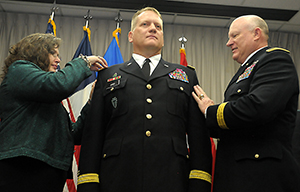Story by: Spc. Christina Clardy
Posted: December 4, 2016
 Maj. Gen. James K. "Red" Brown, U.S. Forces Command Deputy Commanding General - Reserve Component and former 36th Infantry Division Commanding General, and Amy Aris promote Charles "Chuck" Aris to Brig. Gen. on Sunday, Dec. 4, 2016, at Camp Mabry, Austin, Texas. He is joined by family, friends and colleagues to celebrate his promotion at a ceremony and following reception at the Texas Military Forces Museum. Aris has been selected to deploy to Afghanistan as the Commander of the Train, Advise, Assist Command -- South during the 36th Infantry Division's second command rotation in support of Operation Freedom's Sentinel. (U.S. Army National Guard photo by Sgt. 1st Class Michael Leslie)
Maj. Gen. James K. "Red" Brown, U.S. Forces Command Deputy Commanding General - Reserve Component and former 36th Infantry Division Commanding General, and Amy Aris promote Charles "Chuck" Aris to Brig. Gen. on Sunday, Dec. 4, 2016, at Camp Mabry, Austin, Texas. He is joined by family, friends and colleagues to celebrate his promotion at a ceremony and following reception at the Texas Military Forces Museum. Aris has been selected to deploy to Afghanistan as the Commander of the Train, Advise, Assist Command -- South during the 36th Infantry Division's second command rotation in support of Operation Freedom's Sentinel. (U.S. Army National Guard photo by Sgt. 1st Class Michael Leslie)
AUSTIN, Texas — Colonel Charles "Chuck" Aris, the Assistant Division Commander of Support, was promoted to the rank of brigadier general in a ceremony on Sunday, Dec. 4, at Camp Mabry.
Maj. Gen. James K. "Red" Brown, the Deputy Commanding General — Reserve Component, United States Forces, promoted Aris to his one-star rank with his friends, family members and colleagues present.
During the ceremony, Brown, a former commanding general of the 36th Inf. Div., and Aris' wife of 26 years, Amy, pinned the new general's rank to the shoulders of his uniform. His son Matthew and daughter Kate presented him with a one-star general's flag, a traditional general officer's belt, and a desk placard. As per Texas tradition, Aris then gave bouquets of yellow roses to both his wife and his mother, Janice.
"Aris is one of those officers that we always knew was going to rise to the top," said Brown. "He and his family are the ultimate traditional National Guard family. As a civilian, Chuck is a very distinguished and a very successful attorney, who doesn't have to do this; but he chooses to do so as a service to this great state and this great nation."
Because of his dual military and civilian careers, several military dignitaries and civilian colleagues attended the ceremony, including Maj. Gen. John F. Nichols, the Adjutant General of the Texas Military Department, Maj. Gen. Lester Simpson, Commanding General of the 36th Infantry Division Commander, and fellow attorneys from his law firm. Aris, a resident of Waxahachie, Texas, is also a partner with the Dallas-based Byrne, Cardenas and Aris Law Firm, where he handles civil litigation.
"I want to say thank you to every senior leader, every mentor and every person in my life who has supported, trained, and guided me," said Aris. "But I need to say 'thank you' to my family, because without them, their love and their support, I would not be standing where I am today."
Aris will deploy to southern Afghanistan next year as the Commander of the Train, Advise and Assist Command -- South in support of Operation Freedom's Sentinel.
"Its an honor to be selected for this [promotion and deployment]," said Aris. "I pledge to do my very best to make sure that we excel in this mission and continue the great heritage of the Texas Army National Guard."
His most recent assignments include serving as the acting Assistant Division Commander of Maneuver, division Chief of Staff, and Commander of both the 56th and 72nd Infantry Brigade Combat Teams. He served as a task force commander during a 2005 rotation to Kosovo, and deployed to Iraq in 2009 as an assistant chief of staff in operations.
In 1998, he received a Bachelor of Arts degree and commission from the Texas A&M University and was awarded as a Distinguished Military Graduate in the ROTC program. After serving on Active Duty in the Army, in 1993 he joined the Texas Army National Guard. Aris also holds a Master of Science from the Army War College and a Juris Doctorate from South Texas College of Law.
Aris’ awards and decorations include the Legion of Merit, Bronze Star Medal, Meritorious Service Medal (with two Oak Leaf Clusters), Kosovo Campaign Medal, Iraqi Campaign Medal (with two service stars), Global War on Terrorism Service Medal and the Humanitarian Service Medal.
The mission of the 36th Infantry Division is to provide ready and responsive forces that can deploy to conduct unified land operations in joint and coalition environments, in support of a geographical combatant commander. On order, the division provides defense support to civil authorities within the United States in support of state and federal agencies.